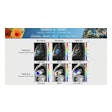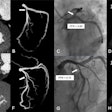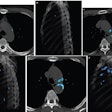Our April 11 story on the difficulties radiologists face in their heart-to-heart imaging competition with cardiologists brought a vigorous rebuttal from a leading academic radiologist. In dueling editorials on cardiac imaging, Dr. David C. Levin calls Dr. Gabriel P. Krestin's views unnecessarily pessimistic, and says radiology has inherent advantages that will ensure it a big piece of the imaging pie. Then Krestin weighs in with a response of his own.
Can radiologists win the battle for coronary CT angiography (CCTA)? In my opinion, the answer is absolutely yes! My thinking about this was spurred by a recent article on AuntMinnie.com, "Cardiac imaging dazzles, but radiologists can't compete alone."
The article featured comments by Dr. Gabriel Krestin from the Netherlands and is, I feel, unnecessarily pessimistic about the role of radiologists in this procedure. Radiologists definitely can compete alone. I agree with Dr. Krestin that under ideal circumstances, radiologists and cardiologists should work together on CCTA.
However, the two specialties do not have a good track record of working together in the U.S., and more often than not, cardiologists have tried to push radiologists out of the picture. Witness what happened in invasive coronary angiography and echocardiography.
But if attempts by radiologists to collaborate with cardiologists on CCTA fail, radiologists should go it alone, and here's why I think they will win.
Imagine this perfectly plausible scenario: You (a hospital radiology department or private practice) begin performing CCTA on your 64-slice scanner. A 30-person cardiology group decides to acquire its own scanner in an office across the street and go into competition with you. There are several reasons why I think such a venture will fail. First, who will refer cases to them, outside of their own group? Certainly no competing cardiology groups will do so. They will refer to you instead.
Many or maybe even all primary care physicians in the area will refer to you also, since they know you won't steal their patients. There is often no love lost between cardiologists and cardiothoracic surgeons, so the surgeons will likely refer to you as well. One of the beauties of CCTA is that the workup of the patient with suspected coronary artery disease (CAD) can be completed before the patient is referred to a cardiologist. As we all know, many patients with symptoms suggesting CAD turn out to actually have other causes of those symptoms.
Second, if the cardiology group has such a narrow referral base, how will it make a go of it financially? Can the group survive on the six or eight CCTAs it might generate per day? On the other hand, your radiology practice can do those six to eight CCTAs each day plus 50 other head, chest, and abdomen CTs. Certainly no one will refer those kinds of cases to a cardiology office.
Third, the Deficit Reduction Act of 2005 substantially reduces technical component reimbursements for private office MR and CT. This makes it hard for anyone -- radiologists or cardiologists -- to be financially successful in an outpatient imaging center. Perhaps the one silver lining in this cloud is that it will discourage nonradiologist physicians from trying to get into the imaging business.
Even with their ability to self-refer, the DRA is going to make it exceedingly difficult for cardiologists to purchase an expensive CT unit, cover build-out costs, pay rent, pay for the service contract, hire all the necessary personnel, purchase the needed supplies, etc., and still be left with any profit at the end. But at least radiologists have all those noncardiac cases to help cover their costs.
For their part, cardiologists need not fear that CCTA by radiologists will ruin their practices. In our department at Thomas Jefferson University Hospital in Philadelphia, we have a busy CCTA practice (performed entirely by us radiologists). On many occasions we have studied patients with few or no symptoms but with strong risk factors, found significant coronary artery disease, and referred those patients to the cath lab for coronary angiography and percutaneous coronary intervention.
Those patients would probably not have been catheterized otherwise. We have also studied many individuals with atypical chest pain and found normal coronary arteries, thereby saving them a trip to the cath lab. All things considered, it's probably a wash for the cardiologists, and it is certainly good care for patients.
Some cardiologists have, of course, already started doing CCTA. One inconvenient problem for them is that many patients have other significant noncardiac findings on their scans. Even the most aggressive cardiologists will concede that they are not able to read the noncardiac portions of the studies. Instead, they will contract with a radiology group to interpret the lungs, mediastinum, pleural spaces, spine, etc., usually for a small fee. In my opinion, any radiologist who agrees to such an arrangement is making a big mistake by willingly accepting a subservient role.
If radiologists everywhere refused to do this unless they were given a full share in reading the CCTAs as well, the cardiologists would have no other option but to agree to full collaboration. But I'm not naive; I know some radiologists will acquiesce just to keep the cardiologists happy, or to make a few extra bucks, or perhaps they are pressured to do so by their hospital. But my advice to any radiologist offered this arrangement: Don't do it! Just say no -- unless the cardiologists offer a true collaboration.
At the height of the Great Depression in the 1930s, U.S. President Franklin D. Roosevelt famously stated, "We have nothing to fear but fear itself." Similarly, the only way radiologists will lose this battle is if, out fear of a confrontation, they simply decline to fight it.
By Dr. David C. Levin
AuntMinnie.com contributing writer
May 29, 2006
Dr. David C. Levin is a professor emeritus and former chairman of the department of radiology at Thomas Jefferson University Hospital and Jefferson Medical College in Philadelphia.
Click here to read Dr. Krestin's response.
Related Reading
Am I not destroying my enemies when I make friends of them? May 24, 2006
Cardiac imaging dazzles, but radiologists can't compete alone, April 10, 2006
Interventional radiology needs rebranding, revitalizing, March 7, 2006
Radiologists maintain dominance in breast biopsy procedures, January 10, 2006
Radiologists retain MRI turf, for now, December 1, 2005
Copyright © 2006 AuntMinnie.com















